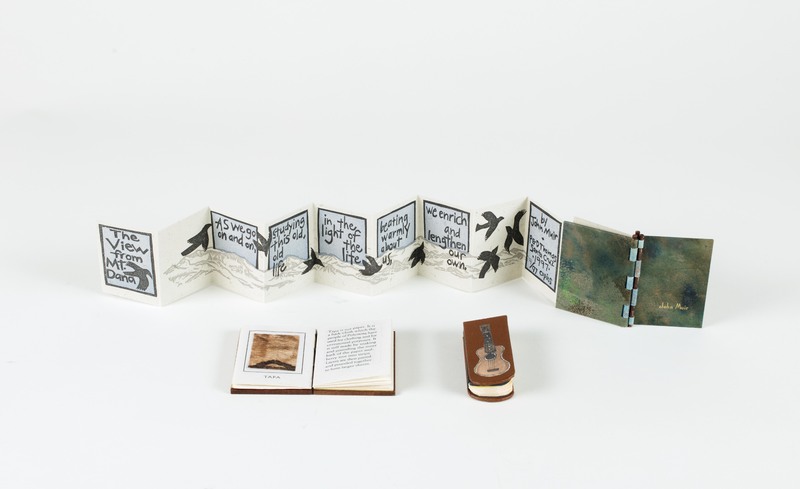A88. The View from Mt. Dana
(Back) A88. John Muir. The View from Mt. Dana. Santa Cruz, California: Peter & Donna Thomas, 1997.
66.5 x 51 mm (2 5/8” x 2”), 9-page accordion, 97 copies.
Binding: Case-bound fold out accordion; piano-hinge binding. The dowels that form the spine are woven through slits in both the cover paper and accordion text block. Covers are handmade paper, decorated by Donna Thomas with acrylic paint and crayon, over boards. “John Muir” in gold on cover. Paper: White with visible fibers, handmade by Peter Thomas. Printing: Letterpress; printed from linoleum blocks. Typography: All text linocut by Donna Thomas. Illustration: Linocuts of birds, mountains, and shapes by Donna Thomas spanning entire accordion.
“Donna skied up Mt. Dana, in Yosemite, during a winter snow camping trip. Near the top, as she watched crows circling overhead, she was inspired to cut blocks for a book. She paired her illustrations with a quote about nature enriching life by John Muir. We had recently been exploring the idea of using a wooden dowel as a major structural element of the binding. Many people expressed interest in these structures. We began to notice that other artists were also making books that used dowels or wooden skewers. We joked that the accordion book had seen its fifteen minutes of fame and the next bookbinding fad would be books made with dowels. With some further thought we gave the genre a name: ‘stick structures.’ I challenged Donna to design a new stick structure binding for the book. The result was her combination of a piano hinge with an accordion book, where the accordion also acted as the spine. She called this the dowelled hinge spine accordion book, and it is a featured project in More Making Books by Hand [F1]. Like Climb the Mountains [A79], this is a block book: both the text and illustration were cut into the linoleum blocks that were used to print the book.”
(Front Center) A90. Peter and Donna Thomas. Almost Paper. Santa Cruz, California: Peter & Donna Thomas, 1997.
73 x 54 mm (2 7/8” x 2 1/8”), 20 pages, 100 copies.
Binding: Coptic binding. Covers are wooden boards. End sheets green and yellow. Paper: White, handmade by Peter and Donna Thomas. Printing: Letterpress. Text printed from polymer plates. Illustrations printed from wood blocks. Typography: Digitally set. Text in Centaur. Titles in Lithos. Illustration: Samples of paper-like materials tipped in. Notes: Miniature Book Society Distinguished Book Award, 1998.
“Listening to a lecture given by Ken Grabowski at a Friends of Dard Hunter annual convention about how ‘rice paper’ is not really made from rice, I envisioned making a book with samples of all the things that were thought of as paper but not really paper. Included are tapa, amate, parchment, papyrus, Tyvek, and wasp nest with actual samples of each material. In this book we further explored the acrostic theme, printing blocks of wood in various sizes and colors under the front natter text.”
(Front Right) A91. Peter and Donna Thomas. A Brief History of the Ukulele. Santa Cruz, California: Peter & Donna Thomas, 1997.
73 x 54 mm (2 7/8” x 2 1/8”), 22 pages, 50 copies.
Binding: Case-bound accordion; glued at spine. Quarter-bound in black Morocco leather and brown goatskin over “U” shaped boards. Illustration on label on cover. End sheets black, fore edge cut in the shape of a ukulele. Paper: Yellow, handmade by Peter Thomas; fore edge cut in the shape of a ukulele. Printing: Digital. Typography: Reproduction of text handwritten by Donna Thomas. Illustration: Reproductions of twenty watercolor paintings of ukuleles by Donna Thomas. Notes: Includes pop-up panels in valley folds.
"The first editioned books Peter and I made were letterpress. That technology was best suited to line drawn art, so my illustrations were woodcuts, linocuts, or pen and ink drawings printed from photo engravings. My artistic palate was limited. Printing full-color woodcuts was difficult and I would often hand paint my illustrations to get colored illustrations in our books. When digital technology became accessible to me, I discovered that a laser copier could be used to print my color images onto Peter’s handmade paper. I had already been making one-of-a-kind books with my own calligraphy and illustrations, and this allowed me to make editioned books using the same techniques.
Peter was starting to play ukulele at this time, at the forefront of the modern revival of interest in the ukulele, and he was in contact with Jim Beloff who was writing the first published history of the ukulele. This became the first miniature book to document the history of the ukulele, and the first editioned book I made using digital printing technology to reproduce one of my original one-of-a-kind books. My aim in making this image-rich edition was to both inform and engage the reader. I wanted them to experience visual delight as they read the text, and be enriched not only by the information, but by the images, the unique page format with the pop-up panels, and the sumptuous rounded bottom leather binding - all these aesthetic attributes contributing to their experience of reading the book.” – Donna Thomas
